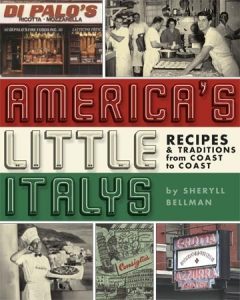About the Author:
Sheryll Bellman is a prolific author of books that focus on culinary and restaurant history in the United States. Her two most significant texts trace the history of America’s Little Italy neighborhoods and the American delicatessen. She also has authored various New York City guides, including a full-length text on Christmas windows in New York City. Bellmann received a B.S in Microbiology and a PhD in Immunology, but her greatest passion is reserved for all things food and culture.

(Bellman, 2010)
Cookbook Genre:
- Historical Relevance of the Publication Date: “America’s Little Italys” was published in 2010.
- Cookbook Structure: The cookbook focuses on food and restaurant culture in America’s ‘Little Italy’ neighborhoods. The book is organized alphabetically by state, then city, and then restaurant. Each restaurant entry includes a historical blurb and recipes for which the restaurant has become famous. The recipes in the cookbook are numerous and varied; there is no way to search for a specific recipe or dish because the book organizes itself by geography.
Type of Cookbook: This cookbook aims to tell the story of Italian American history and food. It is not a celebrity-focused or health-oriented cookbook; rather, it showcases a specific cultural group. This would be considered a specialty cookbook because it highlights the cuisine of a specific ethnic group and, more particularly, the restaurants that are best known in ‘Little Italy’ neighborhoods, or Italian cultural enclaves, in the United States.

(Bellman, 2010)
Audience:
The intended audience could easily be understood as Italian Americans, but it is also written for people who support the cultural ideologies and values of Italian-American communities in the U.S. Family, sustenance, and ethnic pride are all important values that Bellman wants the audience to share or at least understand. At the same time, she also wants the audience to realize that people of Italian ancestry love America and came here for the “American Dream”. “America’s Little Italys” may also draw in authenticity seekers because the cookbook showcases specific restaurants because of their perceived authenticity.
- Authenticity: Claims of authenticity can be used to entice, alienate, manipulate, as well as lie to the general public and targeted groups of people. Otherizing and traditionalization are concepts central to the promotion of authenticity and both can be applied to Italian cooking as well.
- Otherizing: When Italian immigrants began arriving in the US, they were not considered white. Instead, they were understood as an “ethnic minority” and subject to discrimination. Throughout this book, Bellman shares stories of these first immigrant families who were otherized by mainstream American culture. Not only were Italian-Americans excluded from belonging, their food was also understood as exotic and subject to derision.
- Traditionalizing: Traditionalizing is more prevalent today because Italians are less often otherized and their food is more widely praised. This entire cookbook is a product of the traditionalization of Italian food. Italian food in the United States can never be as “authentic” as food prepared in Italy, but the restaurants in Little Italy neighborhoods around the country strive to be as traditional as possible.
Food Systems:
- Ingredients (Taste as a skill): In Italian cooking, fine ingredients are essential. The history, origin, and quality of ingredients are always prominently featured Italian cooking. In this cookbook, it is apparent when Bellman specifies the brands of products that you should use, as well as the out-of-the-ordinary and niche Italian ingredients that are likely to be found exclusively at an Italian market. For example, when Bellman notes that “Mike’s ‘Isabella’ olive oil” and “Mikes ‘Christian Michael’ balsamic vinegar” (Bellman, 2010, p.106) are preferred, she is sharing very specific instructions with the reader. Similarly, when Bellman’s recipes call for “Italian sausage…Italian tomatoes… Italian rolls” (Bellman, 2010, p.160), the reader should understand that these ingredients are best found at a specialty Italian market rather than a local grocery chain. Italians also certify food from specific regions in order to help the national economy and regulate the quality of product. This certification is the DOP (Denominazione di Origine Protetta (literally meaning the“Protected Designation of Origin”). The DOP guarantees that food products are made with traditional and region-specific ingredients in traditional ways. For this reason, taste is best understood as a skill in Italy, and the ingredients are heavily scrutinized.
- Methods: Cooking methods in this cookbook can be both time-consuming and demanding. Whether you are asked to make pasta from scratch (Bellman, 2010, p.132-3) or devote a great deal of time to chopping (Bellman, 2010, p.182), mincing (Bellman, 2010, p.166), and slicing (Bellman, 2010, p.83), you will need to commit yourself to your food preparation and grow comfortable with a wide variety of cooking methods. The cookbook, however, seeks to make the recipes as clear as possible and explains the cooking techniques as it calls for them.
- Technology: There are certain kitchen tools that are common to many of the recipes. For example, a pizzelle iron and meat grinder do not tend to be commonplace items in an American kitchen. Some of the recipes call for fairly obscure technological items. For example, Bellman describes the “special tools: pizzelle iron, cannoli forms, [and] pastry bag with rosette tip” (Bellman, 2010, p. 86) that are required to make cannolis.

(Palmer, 2020) (Jaclyn, 2015)
(Jaclyn, 2015)
- Techniques: Italian technique is also very important to food preparation. If you want to create Italian dishes, you must learn how to roll noodles, cook risotto, spice the water, and fill the cannolis. If you are looking to perfect your noodle making technique, Bellman tells the reader that you should “roll the dough into long ‘snakes’ about ½ -inch in diameter. Cut the snakes into 1-inch-long sections and roll a pastry cutter across the top to create a design” (Bellman, 2010, p. 133). The competence and artistry of your technique contributes to the authenticity of the food.
 (Bellman, 2010)
(Bellman, 2010)
Identity:
- Biocultural Framework:
- Technology: Food technologies unify the culture. Pizzelle irons, for example, are solely Italian and tend to be found in Italian kitchens (as well as passed on generationally). They represent the culture and unify it.
- Ideology: The values of family and cultural heritage are most powerful. Cooking and eating together are essential, and honoring your family–no matter how extended–is a necessity in Italian and Italian American culture.
- Social Organization: Women’s place in the kitchen may be important, but men still rule most other decisions. While everyone may help to cook, the matriarch is given the final say in the kitchen. The patriarch, on the other hand, gets the final say in the other decisions.
- Physical environment: The food system that produces and provides the ingredients is critical to Italian cooking. The expectation that one will want to use specialty ingredients can be a source of pressure, as it is dependent on a food system that is subject to vulnerabilities (i.e. weather and climate, disease, obstacles to distribution).
- Socioeconomic Environment: Cooking Italian food at home not only affirms your ancestry or your passionate attachments to Italian culture, it can also save you money. Italian restaurant cuisine can be costly, especially if you are eating at a restaurant that sources rare and high-quality ingredients.
- Gender Roles: Men tend to be honored and respected–if not over-rewarded–in Italian culture. This is evidenced by the dedication page of the book; the dedication only thanks to the men in her family, not the women. She gives her male ancestors sole credit for immigrating to the US. and she lauds their strength and hardship without mentioning the contributions of her female ancestors. Bellman specifically states that her work is dedicated “to Papamar and Papa and to all of the grandfathers and great grandfathers that had the courage to immigrate to the United States under conditions that were less than perfect to seek a more secure life for their families. We are all indebted to them” (Bellman, 2010, Dedication page).
- Ethnicity/National Origin: The entire cookbook is centered on the cultural origins of Italian immigrants to the United States. This narrative is detailed through a timeline and reinforced in the stories of individual Little Italy neighborhoods and restaurants. Ethnicity is essential to this cookbook, as the immigration experience continues to powerfully shape these centers of Italian culture. For example, when describing a Little Italy neighborhood that is home to some of the most authentic Italian food, Bellman describes it as an “…very ethnic, very safe neighborhood– a bastion of Neapolitian cooking– you feel as if the immigrants, who came here in the early part of the twentieth century from Southern Italy (Calabria and Bari), never left their homeland”(Bellman, 2010, p. 89).

(Bellman, 2010)
- Health Rhetoric: In this cookbook, Italians and Italian Americans tend to care more about the “Italian-ness” and deliciousness of the food than its health and nutritional value. The use of fats, oils, red meat, and bread are prevalent. But, at the same time, vegetables are integrated into almost every dish, whether as a side, sauce, or primary ingredient. The only thing that is overtly questionable and unbalanced is the suggested use of MSG (Bellman, 2010, p.166), specifically in meatballs.
- Foodways: Culture and food are interlocking in Italian and Italian American cuisine. This cookbook would not be as impactful if it did not explain the individual foodways of each of the restaurants. The stories are what makes the reader want to visit the restaurants in order to sample the dishes or create a version of the dish from scratch at home.
Contextualization:
- Italian History Timeline: The first fifty pages of the text are a timeline of modern Italian history. In these pages, we learn about subjects as varied as the conquests of Italian explorers and colonizers, the growth in popularity of certain Italian foods, and the launch dates of popular Italian food brands.

(Bellman, 2010)
- The Paradox of Italian Food in the US: Do we want Americans to only understand and experience Italian food as it is currently promoted? Should Italian food be Americanized? Should we celebrate fast-food pizza or support only family-owned, non-franchise Italian restaurants? It can be hard to decide whether or not Italian food in the United States honors or dishonors Italy. Certainly, 21st century Americans love “Italian food,” but one can ask: is that food truly Italian? Does it embody–or try to embody–Italian cultural and culinary values and customs?
\
(Valdosta, 2011)
(Hughes, 2014)
References:
Bellman, S. (2010). America’s Little Italys: Recipes & Traditions from Coast to Coast. Sellers Pub.
Ciprietti, E. (2013, July 23). DOP foods of Italy: What they are, and how to find them. https://www.walksofitaly.com/blog/food-and-wine/dop-foods-from-italy
Hughes, C. (2014, March 11). Sbarro Pizza Bankruptcy: Fast-Food Chain Files 2nd Time in 3 Years. https://www.newsmax.com/TheWire/sbarro-pizza-bankruptcy-files/2014/03/11/id/558782/
Our Story — That’s Amore Gelato. (n.d.). from https://www.thatsamoregelato.com/our-story
Palmer Pizzelle Maker, Model 1000. (n.d.). from https://www.fantes.com/palmer-pizzelle-maker-model-1000
Sheryll Bellman. (n.d.). from http://www.sheryllbellman.com/
VALDOSTA GEORGIA Lowndes college restaurant attorney Dr.Hospital bank church hotel fire dept.Store. from http://valdostageorgia.blogspot.com/2011/07/fazolis-italian-food-valdosta-georgia.html